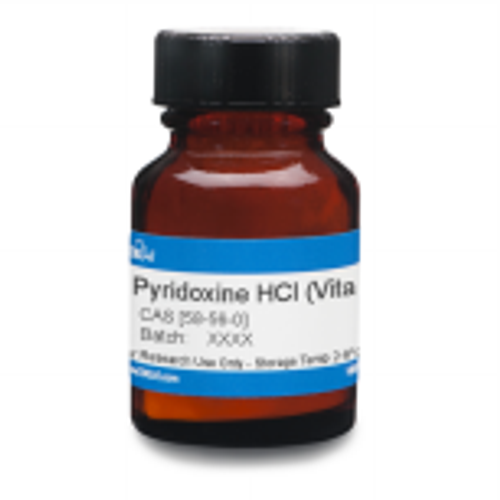Pyridoxine Hydrochloride (syn: Vitamin B6) is the hydrochloride salt of Pyridoxine. It is a pyridine derivative and is involved in a variety of enzymatic transformations and plays a role as an antioxidant in biological systems. Pyridoxine was isolated and crystallized in 1938 by Samuel Lepkovsky. It can be converted in animals into the enzymatically active form pyridoxal-5-phosphate. Pyridoxal-5-phosphate is used in metabolic utilization and transformation of amino acids and is a cofactor in the synthesis of neurotransmitters and sphingolipids.
Pyridoxine Hydrochloride is soluble in water and DMSO but insoluble in ethanol.
| Mechanism of Action | Pyridoxine serves as a precursor of pyridoxal-phosphate (PLP), a coenzyme for amino acid and nucleic acid metabolism and neurotransmitter synthesis. |
| Eukaryotic Cell Culture Applications | Pyridoxine was used in a stably transformed Chinese Hamster Ovary (CHO) cells expressing normal and mutant forms of AGT (alanine:glyoxylate aminotransferase) in the study of primary hyperoxaluria type 1 (PH1), a rare heriditary calcium oxalate kidney stone disease caused by AGT deficiency. Researchers showed Pyridoxine increases the expression, activity and import of the most common mistargeted mutant forms of AGT. This demonstrates that Pyridoxine, which is metabolised to pyridoxal phosphate (the essential cofactor of AGT) acts as a prosthetic group and chaperone. This should help to aid pharmacological treatments of PH1 (Fargue et al, 2013). |
| Molecular Formula | C8H11NO3 · HCl |
| References |
Fargue S, Rumsby G, Danpure CJ (2013) Multiple mechanisms of action of Pyridoxine in primary hyperoxaluria type 1. Biochim. Biophys. Acta. 1832(10):1776-7178 PMID 3597595 Rosenberg IH (2012) A history of the isolation and identification of vitamin B(6). Ann. Nutr. Metab. 61(3):236-238 PMID 23183295 Singh VP, Poon JF, Engman L (2013) Turning pyridoxine into a catalytic chain-breaking and hydroperoxide-decomposing antioxidant. J Org Chem.78(4):1478-1487 PMID 23316758 |








